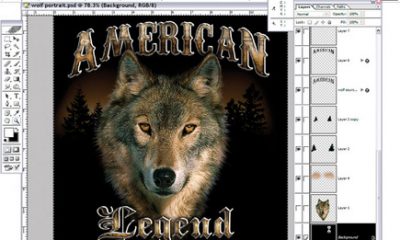Digital Printing
Published
17 years agoon
The digital-imaging community has not been contacted by Al Gore’s team, though now may be an opportune time to address the options for eco-friendly printing. Why should we pursue ways to make our products environmentally sound? One reason is because it’s a wonderful story to tell our clients and one they’ll appreciate. And although the initiative probably won’t save money for the company or our clients, it’s simply the right thing to do.
Why is this now on my radar screen? A very good client has asked my company to pursue eco-friendly alternatives for its customer. Now I’d like to share with you some of the findings I uncovered as I researched alternatives for producing a green, digitally printed point-of-sale product.
When clients make a request for eco-conscious printed materials, what are they really asking for? In my opinion, the client is looking for a final product onto which we can stamp something to the effect of “Our earth does not have a problem with our P-O-S materials.” Is this possible? Let’s break it down.
My initial research led me to separate the world of green large-format printing into two main areas of concern: substrates and inks. Subcategories address whether the consumables are biodegradable, recyclable, made with recyclable or renewable products, better for the environment, and finally, better for your employees—the ones who work with the materials.
The graphic process that is associated with our discussion of eco-friendly can be displayed in the following workflow: design→ raw materials/consumables→ print manufacturing→ use of the P-O-S products→ end of life (disposal). Intervention in each of these areas can have a great impact on the green factor of the product.
Design and materials
The design of the imagery will relate directly to the type of materials and equipment that will be utilized to produce the prints. If the goal is an eco-friendly product, the marketing/ design people need to be involved up front. For example, if the product requires back lighting, then the flexibility of substrates, energy utilization, ink durability, etc., will be very narrow.
Your choice of raw materials may impact the durability and cost of the project. The design of the piece and the budget drive your options. Adding materials such as protective coatings, adhesives, and laminates to the raw substrate makes the final product less recyclable.
The substrates for point-of-sale displays range from plastic to paper products. As you weigh your options, keep in mind how biodegradable or recyclable the product is and whether it’s made with recyclable or renewable components. What we apply to the substrate in production—ink, coatings, laminates, and so on—can render the final product non-recyclable. In other words, the graphic will probably end up in a landfill.
Underneath the plastics umbrella are polystyrenes, foam boards, rigid vinyls, polycarbonates, acrylics, PETG, and PVC. As raw materials, these items have nice recycling properties; however, their own manufacturing processes require the use of petroleum products and are not kind to the environment. Paper products include corrugates and paperboards (12-40+ pt). These items are very eco-friendly and can be purchased with a certain percentage recycled contents.
Kenaf is an interesting alternative to traditional papers. A 4000-year-old crop with roots in ancient Africa, Kenaf cotton and okra grow well in many parts of the US. Kenaf offers a way to make paper without cutting trees. It grows quickly, rising to heights of 12-14 ft in as little as four to five months.
Print methods
Print method determines the final product’s eco-friendliness. Using mild solvent inks can reduce VOCs and toxicity. Direct printing with UV-curable inks completely eliminates the VOC issue, though it requires more care from ink handlers. Waterbased inks may have reduced durability, but P-O-P items tend not to require significant outdoor strength or resistance toyears of exposure. How about the use of thermal inkjets with water-based inks? Unfortunately, adhesives are required to mount images produced on aqueous inkjets, and then a top laminate typically is necessary for durability. All in all, this method reduces the ability to recycle.
Fabric has come onto the scene in our P-O-S world. Natural and man-made fibers are the split for fabric products. Fabric is direct printed with solvent or UV-curable inks, or decorated with a dye-sublimation transfer. One example of a greener alternative is DuPont’s Sorona polymer, which contains 37% renewably sourced material (by weight). It is derived from corn, which replaces petroleum-based 1,3-propanediol.
In general, fabrics made either partially or completely from recycle PET polyester (pop and water bottles), sustainable resources (Sorona polymer), and natural fabrics such as cotton, linen, silk, hemp, bamboo, soy, and milk-protein based fabrics, advance the eco-friendly alternatives. Direct-print fabrics usually require a pre-coating for maximum printability, which can make a very green fabric into an eco-adverse material.
The ink options for fabric can be very positive, as dye sublimation uses a water-based ink for the transfer process, and so does the direct print method of Dupont’s Artistri printer. As you can imagine, direct printing with solvent inks onto pre-coated fabric would not be the green alternative.
Green manufacturing processes and materials are rendered null if the ink is not eco-friendly. Traditional petroleum-based inks contribute to toxic compounds released into the environment by the printing industry. Ink affects the environment through transfers and releases. Transfers refer to chemicals that need to be further processed or disposed of and are released in the form of VOCs, a leading source of groundlevel ozone that leads to smog and other health hazards. Biochemicals, or plant-matter-based materials, exist as an alternative. They save money and improve worker safety, reduce the health risks associated with petrochemicals, and create a safer work environment.
Also note that the top ten polluting chemicals are all petroleum-derived. Toluene ranks first. These products are used in press-cleaning operations and as ink components.
Disposal
If my client, who is pushing for the green stamp of approval, does not have a program to recycle P-O-S graphics, which I have tried so hard to render eco-friendly, what next? I can take the final step and assist in the de-installation and removal of the P-O-S product, which adds revenue and is a great solution to tie design and production into a green system.
Have I found the magic bullet for achieving green, digitally produced display graphics? Well, not quite yet. It doesn’t help that everyone defines green printing differently and that we lack a standard or certification for what makes a printer, or a given project, green. Still, if you want to differentiate your company and raise the banner for a green alternative to conventional digital printing, you will have very little competition. You will develop a wonderful and rewarding marketing concept, and clients may like the story enough to send their business your way.
Rick Mandel is the owner and president of the Mandel Company in Milwaukee, WI. He also serves as CEO of the company’s Screentech Division, a 115-year-old graphics firm that specializes in large-format color separations for commercial printing companies, as well as digital production of large-format graphics. Mandel is a member of the SGIA and the Association of Screen Printing Sciences. He holds a bachelor-of-science degree from the University of Wisconsin.

Subscribe

Magazine
Get the most important news
and business ideas from Screenprinting Magazine.
Most Popular
-

 Art, Ad, or Alchemy1 month ago
Art, Ad, or Alchemy1 month agoF&I Printing Is Everywhere!
-

 Case Studies1 month ago
Case Studies1 month agoHigh-Density Inks Help Specialty Printing Take Center Stage
-

 Andy MacDougall1 month ago
Andy MacDougall1 month agoFunctional and Industrial Printing is EVERYWHERE!
-

 Columns2 weeks ago
Columns2 weeks ago8 Marketing Mistakes Not to Make When Promoting Your Screen Printing Services Online
-

 Editor's Note2 weeks ago
Editor's Note2 weeks agoLivin’ the High Life
-

 Thomas Trimingham2 months ago
Thomas Trimingham2 months ago“Magic” Marketing for Screen Printing Shops
-

 Marshall Atkinson2 weeks ago
Marshall Atkinson2 weeks agoHow to Create a Winning Culture in Your Screen-Printing Business
-

 News & Trends1 month ago
News & Trends1 month agoWhat Are ZALPHAS and How Can You Serve Them in Your Print Business?






